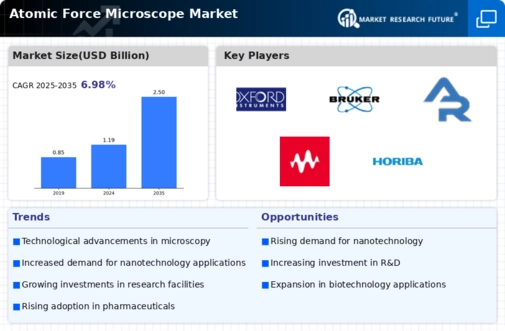Top Industry Leaders in the Atomic Force Microscope Market

The Competitive Landscape of the Atomic Force Microscope Market
Atomic force microscopes (AFMs), once confined to the realm of specialized laboratories, are rapidly emerging from the shadows to illuminate the dynamic landscape of nanoscale research and beyond. These versatile tools, capable of imaging and manipulating objects with atomic precision, are fueling advancements in diverse fields, from materials science and semiconductor technology to biological research and nanotechnology. Navigating this dynamic market requires a keen understanding of the competitive landscape, adopted strategies, key players, and emerging trends shaping the future of AFM technology.
Some of the Atomic Force Microscope companies listed below:
- Concept Scientific Instruments
- Advanced Technologies Center
- WITec (Wissenschaftliche Instrumente und Technologie GmbH)
- Park Systems, Anton Paar
- AFM Workshop
- Hitachi High-Technologies Corp (HHT)
- Semilab Inc.
- Bruker Corporation
- Nanomagnetics Instruments
- Nanosurf AG
Strategies Adopted by Leaders:
- Embracing Innovation and Cutting-Edge Technologies: Investing in R&D to integrate novel advancements like high-resolution probes, multi-modal operation capabilities, enhanced automation features, and AI-powered data analysis differentiates solutions and caters to evolving user needs.
- Prioritizing User Education and Technical Support: Providing comprehensive technical documentation, application notes, and robust technical support ensures users leverage the full potential of the AFMs and fosters ongoing customer satisfaction.
- Partnerships and Ecosystem Building: Collaborating with equipment manufacturers, software developers, and research institutions expands reach, offers complete solutions, and strengthens brand presence.
- Focus on Miniaturization and Portability: Developing compact, portable AFMs suitable for field measurements or in-situ analysis opens up new application possibilities and caters to growing research mobility.
- Sustainability and Environmental Considerations: Utilizing energy-efficient components, minimizing waste in production processes, and offering compliant packaging cater to customers with growing sustainability concerns.
Factors for Market Share Analysis:
- Product Portfolio and Technological Breadth: The range and sophistication of AFMs offered, encompassing diverse types like contact AFMs, non-contact AFMs, and scanning tunneling microscopes (STMs), with varying imaging modes, force measurement capabilities, and sample compatibility, significantly impact market reach. Catering to specific applications, such as analyzing proteins on a cell surface or investigating the topography of microchip components, can be significant differentiators.
- Target Market Focus: Focusing on specific segments within the technology ecosystem, such as academic research institutions, semiconductor manufacturers, materials science research, or biomedical companies, requires tailored solutions and marketing strategies. Addressing the unique needs of each segment can solidify market share within that niche.
- Ease of Use and User Interface: Providing intuitive software interfaces, user-friendly operation manuals, and comprehensive training programs simplifies instrument operation and expands potential user base, particularly for non-experts in scanning probe microscopy.
- Data Acquisition and Analysis Software: Robust software platforms for image acquisition, processing, analysis, and data visualization enhance user experience and enable efficient extraction of meaningful insights from the complex AFM data.
- Integration and Compatibility: Seamless integration with existing laboratory equipment, software platforms, and data analysis tools facilitates workflow efficiency and expands adoption opportunities within research environments.
New and Emerging Companies:
- Niche-Focused Startups: Companies like Nanosurf AG and Park Systems Corporation specialize in developing AFMs for specific applications like biomolecular studies or high-temperature materials analysis, offering tailored features and performance optimized for demanding environments.
- Open-Source Hardware Advocates: Companies like OpenAFM Project and Femtotools promote open-source AFM designs and readily available fabrication instructions, empowering researchers and DIY enthusiasts with customization options and fostering innovation within the community.
- Software-Centric Platforms: Companies like Gwyddion and Mountains Technology focus on developing advanced software platforms that optimize AFM data analysis, enable image reconstruction, and provide comprehensive data visualization tools, adding significant value beyond the hardware itself.
Latest Company Updates:
Oxford Instruments Asylum Research today announced the launching of the Cypher ES Battery Edition, a new atomic force microscope (AFM) bundle designed for battery research, in 2023. A variety of EC-AFM studies are made possible by the setup, which combines the ultra-high-performance Cypher ES AFM with an intuitive electrochemistry cell. Fast scanning to capture dynamic processes and unparalleled stability and resolution even when combined with a glovebox for lithium battery research are examples of performance features.
Park Systems, a top supplier of solutions for AFM and nano-metrology, is pleased to announce the introduction of its Park NANOstandardTM product range for 2023. Users may precisely measure and analyse their samples with the help of this new product line, which offers calibration reference samples for AFM and SEM measurements.
